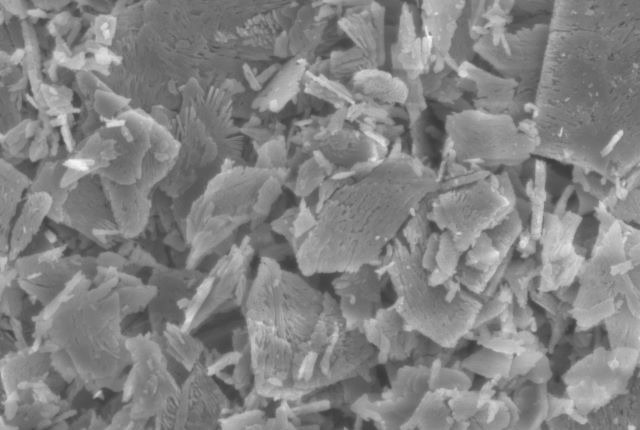Scientists at the Botucatu Institute of Biosciences (IBB-UNESP) at São Paulo State University in Brazil have created a unique biomaterial that accelerates the differentiation of osteoblasts, or bone cells. The innovation could be applied in the future to a variety of operations, including bone grafting, bone regeneration, and dental implant recovery.

Photomicrograph of the material synthesized by researchers at IBB-UNESP. Image Credit: Willian Fernando Zambuzzi/UNESP
According to an article in the Journal of Biomedical Materials Research, the material in question is cobalt-doped monetite, a significant calcium phosphate compound that bears structural similarities to human bone minerals.
Phosphorus, oxygen, hydrogen, and calcium are all present in monetite. It can be used in many biomedical applications, such as injectable bone cement and coatings for prosthetics. The cobalt that the researchers supplied is important for osteoblast differentiation, as will be discussed below.
For the first time, our data produced sufficient evidence based on hypoxia [low levels of oxygen in tissue] that we may have a novel biomimetic material with the potential to regenerate bone tissue. The quantity and quality of autogenous bone available from the patient are not always sufficient for clinical grafting purposes.
Willian Fernando Zambuzzi,, Study Last Author and Professor, Botucatu Institute of Biosciences, São Paulo State University
The grafting techniques currently used for patients with fractures or in need of tumor resection (removal), along with dental prostheses, usually involve using the patients’ own bone fragments. However, obtaining the autogenous material requires additional surgery, which carries a risk of infection, and requires a longer convalescence.
With funding from FAPESP, Zambuzzi has studied bone biology since the early 2000s. Currently, he is the thesis advisor for PhD candidate Gerson Santos de Almeida, who is the study’s first author. For a considerable amount of time, he and his team have focused on studying the molecules and processes that go into the formation of bones while simultaneously searching for appropriate biomaterials.
The majority of countries in the globe are seeing increases in longevity, which has sparked further research on bone regeneration and more potent related therapies. The goal of the research is to reduce treatment costs, decrease hospital stays, speed up patient recovery, and prevent negative side effects. In this setting, it is obviously necessary to develop materials that can mimic the intricacy of bone structure while remaining safe and effective.
Knowledge Construction
Endothelial cells (which line blood vessels) could boost osteoblast development, according to 2014 Nature research, and blood vessel expansion and osteogenesis appeared to be linked, with molecular interplay between endothelial and osteoblastic cells.
Zambuzzi added, “Hypoxia occurs naturally in tissue. Having explored its development and the links between endothelial cells and osteoblasts, we investigated biomimetic aspects and decided on artificial provocation of a novel molecule, cobalt-doped monetite, to stimulate bone production as a complementary effect to intensifying angiogenesis [creation of new blood vessels].”
The innovative material is safe in this regard, according to cytotoxicity testing based on the primary biological evaluation standard for medical devices (ISO 10993:5). The amount of cobalt found to be a critical factor in establishing the appropriate concentration for future biomedical applications, particularly in the field of bone regeneration, was discovered to be a key determinant.
“The basic research results were conclusive, giving us the go-ahead for a more complex analysis via preclinical models, including animal tests, to glean a better understanding of the translational aspects of the material,” Zambuzzi further added.
The group adheres to the three Rs: reduce the number of animals used in studies, replace animals entirely where practicable, and refine to minimize animal distress. However, they see no way to avoid models involving vertebrate physiology at some point in the product development process.
Zambuzzi concluded, “We are on the way to producing novel biomimetic materials that improve the quality of people’s lives while complying with the strictest ethical principles in animal testing.”
Journal References
de Almeida, G. S., et al. (2023) Development of cobalt (Co)-doped monetites for bone regeneration. Journal of Biomedical Materials Research. doi:10.1002/jbm.b.35319.